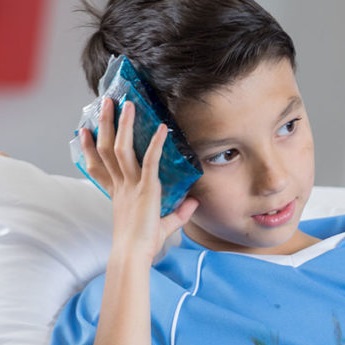Common Myths About Kids and Concussions

March 28, 2019
Children are still growing, so that means they will heal faster from a concussion, right? Not exactly, and it only gets more confusing.
So before our young ones take the field this spring, it is important to understand the risks and misunderstandings about kids and concussions. Savitra Bandari, M.D., assistant professor of Neuroscience and Pediatric Neurologist at JFK University Medical Center, shared her expertise to debunk a few common theories.
Myth 1: It is not a concussion unless consciousness is lost.
A concussion, a traumatic brain injury caused by a blow, bump or jolt to the head, causes the head and brain to move rapidly back and forth. This sudden movement creates chemical changes in the brain and can sometimes stretch and damage brain cells.
“While concussion can result in a loss of consciousness, loss of consciousness is seen in less than 10% of cases,” notes Dr. Bandari. “It’s important for parents and coaches to know that although the child may look fine and they may not have lost consciousness, you should not ignore the subtle signs of injury.”
Myth 2: Children who suffer a traumatic brain injury heal faster than adults.
“People often think that children heal faster than adults when it comes to brain injuries, this comes from the old Kennard Principle. The idea is that because a child’s brain is still in development, it could compensate better than the adult brain, or ‘reorganize’ itself. This is not true. Children actually take longer to heal from a concussion, and the younger the age of the child, the more vulnerable the brain is,” advises Dr. Bandari.
“Children go through significant developments from birth until 18 years of age. Most don’t realize that a child’s risk is even greater than adults – a child’s brain is smaller, and there is more space to move freely about the skull, which causes more damage,” shares Dr. Bandari.
Myth 3: Most concussions are the same, and will heal in a similar time frame.
“Concussions are like snowflakes – no two are alike,” Dr. Bandari notes. “Even if one child has two concussions, they may be totally different. And each child can have a different combination of symptoms.”
“Symptoms can last for days, weeks, or even longer, which is what we’d classify as post-concussion syndrome,” shares Dr. Bandari. “Some post-concussion syndrome symptoms are pressure in the head, nausea, vomiting, dizziness, blurry or double vision, sensitivity to light or noise, feeling tired or sluggish, difficulty paying attention, memory problems, confusion, sleep problems, mood changes and sometimes depression.”
Myth 4: Wearing a helmet offers total protection from concussions.
“Even if someone is wearing a helmet, adult or child, it does not fully protect them from getting a concussion. Wearing a helmet will protect the exterior of your head, however it does not protect the inside – your brain is still free to move about,” cautions Dr. Bandari. “However, that being said, you should still always wear a helmet, as it will absorb any impact energy, rather than your skull or brain taking that blow.”
Myth 5: If my child has a concussion, they should be kept out of school and sports for one to two weeks.
“The amount of recovery time needed will be unique to the patient, and unique to each injury. Older guidelines used to recommend keeping a child out of school and sports for one to two weeks, but that timeframe does not consider the severity of the concussion, or the child,” shares Dr. Bandari.
“After a concussion has been clinically diagnosed, the first step for recovery is to do brain - or cognitive - rest,” Dr. Bandari adds. This means no screen time, phone or TV. They can listen to music, or audio recordings. Ensure they are well hydrated and get a good amount of rest. Then, there are various phases to follow that will ease the child back into normal activities.”
You can find additional details and information on recovery techniques from the CDC Pediatric Mild Traumatic Brain Injury Guidelines.
If your child has experienced an injury to the head, Dr. Bandari offers a simple rule of thumb to follow before allowing your child to return to sports:
“If in doubt, sit them out.”
“Second Impact Syndrome (SIS) is very dangerous. If a child has had a concussion initially, and they get another concussion before fully recovering, there is a severe risk for permanent brain damage and even death,” warns Dr. Bandari. “If a child is still symptomatic, they should not return to sports.”
Next Steps & Resources:
- Meet our source: Savitra Bandari, M.D.
- To make an appointment with Dr. Bandari or a doctor near you, call 800-822-8905 or visit our website.
- Learn more online about our concussion centers.
- Science Daily - Study
The material provided through HealthU is intended to be used as general information only and should not replace the advice of your physician. Always consult your physician for individual care.






